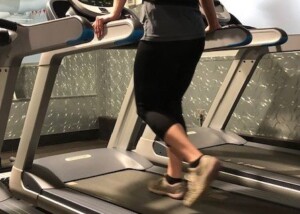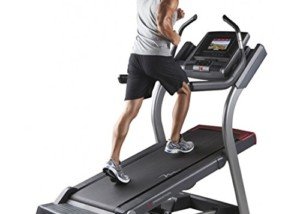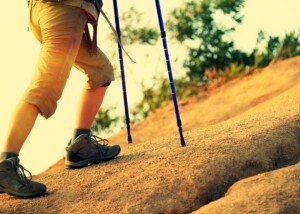
Obese people can begin their hiking preparation safely inside a gym or even their home, but if they want to venture outdoors from the start, that’s fine too.
Obese people are capable of hiking. From time to time, I see “fat” women and men (more so women) on the trails. And on occasion, they are going at a good clip—uphill.
These faster heavy hikers are trained; it’s obviously not their first hike when I see them.
I also see very slow—and thinner—hikers, as well as thin hikers seemingly dependent on trekking poles to get around.
With that all said, here’s my point: Do not let obesity stop you from hitting the trails.
How Obese People Can Safely Train for Hiking: Treadmill
If you belong to a gym, commit to incline walking on a treadmill.
DO NOT HOLD ON. You want to mimic outside hill walking—where there’s nothing to hold onto.
Therefore, holding onto the treadmill will be a waste of time and create a false sense of training.
Start with a five percent incline. The 15 percent grade will quickly fatigue the lower calves in de-conditioned people, so you want to build up low calf resistance.
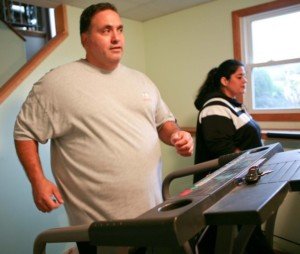
Walk at the same speed you would outdoors. This is crucial, because the vast majority of people, for some mysterious reason, will set the treadmill at an unrealistically fast speed, forcing them to hold onto the machine.
Few hikers walk up a 15 percent mountain trail at 4 mph! Even 3 mph at this grade is pretty stiff. Be realistic.
This means 1.5 to 2 mph at lower inclines and 1 to 1.5 mph at high inclines. This simulates realistic speed for the novice obese hiker.
Do not be tempted to crank up the speed and hold onto the treadmill in the name of appearing like you’re working out.
Trust me, you will NOT appear like you’re working out as long as your hands are holding the machine for support.
Walk hands free, posture straight, arms swinging naturally, with a little perk in your knees—at the realistically slow speed.
Hands free will allow your lower back to develop conditioning, which it will need on a hiking trail—where there’s nothing to hold onto for support (can’t say that enough).
Try 1.5 to 2 mph at five percent for 10 minutes. Increase to seven, then 10 percent. If your calves/Achilles tendons don’t start aching, try 12, 13, 15 percent.
Commit to 30 minutes. If you begin getting really tired, use a zero incline for several minutes to recharge. Then return to the incline. This is interval training and highly effective for hiking preparation.
How Obese People Can Safely Train for Hiking: Revolving Staircase
This equipment is worthless as long as you hold onto the rails! I don’t care if the whole world does this. It is WRONG and effective-less.
Set the stepping speed at the lowest level and begin stepping, HANDS OFF THE RAILS.
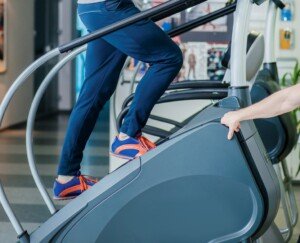
Shutterstock/Maksym Poriechkin
This will force correct posture, make the ankles and calves work, and simulate walking up rocky outdoor trails.
Holding on will de-simulate hiking big-time. Watch someone hiking. Does their body, in any way, resemble the body of someone using the revolving staircase rails for support?
So keep your hands off, spine erect, and keep stepping. Yes, it will be tiring, but cheating by holding onto the rails will not prepare you for hiking. Never.
Increase speed as you are able to. Employing interval training will expedite your training.
How Obese People Can Safely Train for Hiking: Stool Stepping
Step up and down on a 12 inch exercise stool (your gym probably has one, but they’re available online) for five minutes. Do not rush through this.
Try this only if you have stable knees, no diagnosed knee conditions and are no more than moderately overweight.
But if you end up wobbling to stabilize your foot on the step once you get up there, or wobble as you come down, the height is too high; use the bottom stair of a staircase instead.
Build up to 15 minutes — taking your time. There is no need to hold weights.
You can also take step classes, which will train your body in different planes.
Of course, just going out and walking the trails is a great way to build conditioning, and you won’t be tempted to hold onto anything or stop prematurely.
If you get tired you can either just slow down or take a rest and admire the scenery.
Just make sure that before you go hiking, your feet are already used to walking and stepping in the hiking footwear that you will use for the outdoors.
Don’t venture too far from your car, in case you’re suddenly hit with discomfort; stay close to your vehicle until you develop more conditioning.
Do not use obesity as an excuse to refrain from the enjoyment of hiking.
 Lorra Garrick is a former personal trainer certified through the American Council on Exercise. At Bally Total Fitness she trained women and men of all ages for fat loss, muscle building, fitness and improved health.
Lorra Garrick is a former personal trainer certified through the American Council on Exercise. At Bally Total Fitness she trained women and men of all ages for fat loss, muscle building, fitness and improved health.
.

